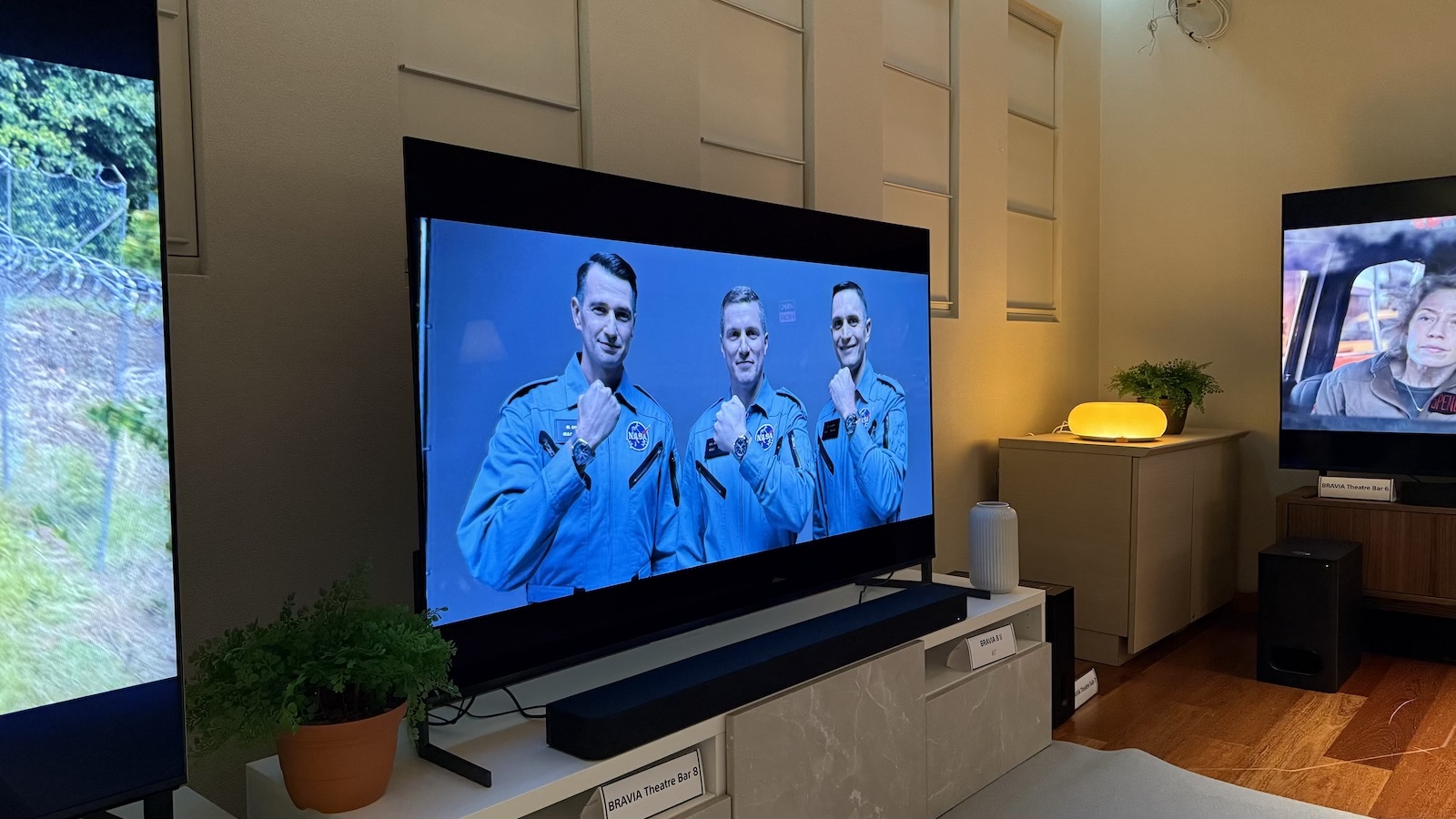What Hi-Fi? Verdict
While seriously impressive in some ways, the 100L9GTUK Laser TV also has some glaring flaws that can’t be ignored.
Pros
- +
Remarkable brightness for a projector
- +
Very sharp 4K images
- +
Feels TV-like in some ways
Cons
- -
Large ‘hot spot’ on the image
- -
Unimpressive black levels
- -
Some rainbow effect
Why you can trust What Hi-Fi?
You’ve got to hand it to Hisense: at a time when pretty much every TV set labours under a model number so boring only an engineer could love it, ‘Laser TV’ sounds seriously catchy. Our ears involuntarily prick up whenever we hear the word ‘laser’, but that counts double when we see it used in the context of a TV world usually restricted to LCD, OLED and Mini LED technologies.
To some extent, at least, Hisense’s Laser TV proposition actually lives up to the hype created by its name. After all, there’s no other TV out there capable of giving you 100 inches of 4K HDR pictures for anything like as little as £4499 / US$5500 / AUS$6999.
The only catch is that ultimately the Laser TV isn’t actually a TV – even though there are times, at least, where it does a pretty convincing job of persuading you otherwise.
Design
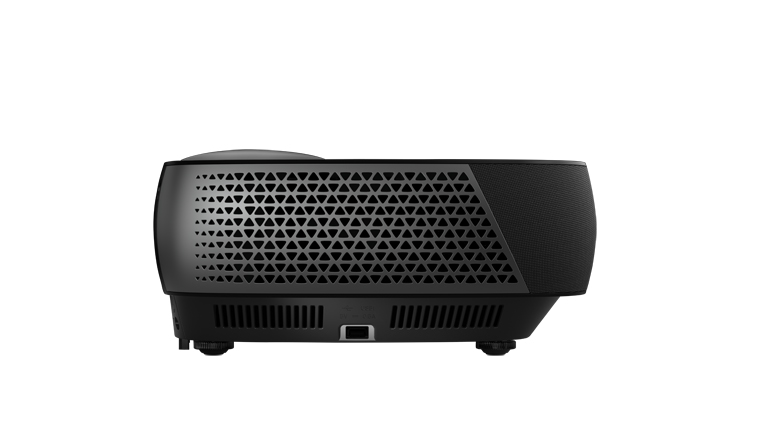
You don’t have to stare for long at the 100L9GTUK (yes, it does have a model name after all alongside that Laser TV classification) to see that it’s not a TV in the normal sense of a TV. Instead it comprises two elements: a 100-inch fixed frame screen, and a separate ultra short throw laser projector. In other words, the Laser TV is actually a projector system. To be fair, though, it is a projector system with a difference.
For starters, the screen is provided as standard with the projector, within the price, as a package deal. What’s more, it’s a package deal that Hisense will even send someone round to install for you – again (at the time of writing), without any additional cost.
The projector is an ultra short throw design that can be placed on a sideboard right next to your wall and a few inches under the screen. So unlike regular projectors, it doesn’t have to be placed in the middle of your room. That’s one early tick for its desire to feel more like a TV than a projector.
Also unlike most projectors, the fairly attractive gloss black finish and rounded corners of its bodywork are accompanied on its back edge – which is actually the bit that faces out into the room – by a 2 x 20W speaker system, complete with built-in Dolby Atmos decoding. Another tick in the ‘I am a TV, honest’ box.
The 100L9GTUK’s connections also have much more in common with TVs than projectors. Especially the provision of three HDMIs when most projectors only carry two; built-in wi-fi to support video streaming via Hisense’s own VIDAA smart platform; and even an RF port feeding into a Freeview HD tuner.
One last point to note here is that the screen is a rigid design, so may be a challenge to get up or down stairs into bedrooms or basements respectively.
Features
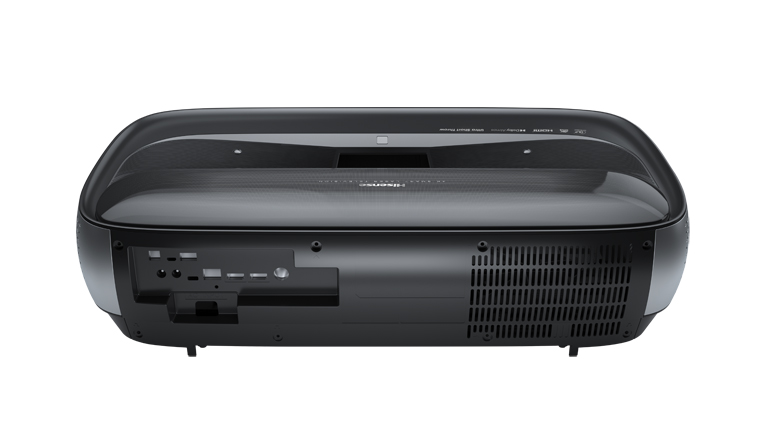
The simple fact that the 100L9GTUK Laser TV can give you a 100-inch picture that feels at least a bit like you’re watching a TV for £4499 / US$5500 / AUS$6999 is the big story here. But there’s plenty of other intriguing stuff to explore, too.
The screen, for instance, is no ordinary projection screen. It deploys ambient light rejection (ALR) technology, where the screen’s structure is able to keep ambient light from hitting the screen by only reflecting light that hits it from below. Below being, of course, where the 100L9GTUK sits.
This ALR screen design in conjunction with the short distance the projector’s light has to travel and the claimed ability of the projector to pump out 3000 nits of light are all key elements in it trying to deliver pictures bright enough to both combat ambient light in a light room, and rival the brightness you can get from regular TVs in a dark room.
The laser part of the 100L9GTUK’s Laser TV configuration warrants more attention too. For starters, crucially it’s a tri-laser arrangement, providing separate laser light sources for the red, green and blue picture elements. Hisense’s cheaper L5 Laser TVs use a mono laser system instead, which means their single-source light has to be fed through a brightness-reducing colour wheel. Not needing a colour wheel should see more of the 100L9GTUK’s light actually reaching the screen, as well as increased colour volume. In fact, Hisense claims the 100L9GTUK covers as much as 107% of the BT2020 colour space and delivers one billion colours.
Using a laser lighting system removes the burden of having to keep replacing the bulbs/lamps associated with non-laser projectors. The 100L9GTUK’s lasers are rated as good for more than 25,000 hours of working life. That works out at 12,500 two-hour films, or 4166 days of viewing based on an assumed six hours of daily use.
What’s more, since lasers lose much less performance over their lifetime than lamps do, you will experience vastly more hours of high level performance over the lasers’ lifetime.
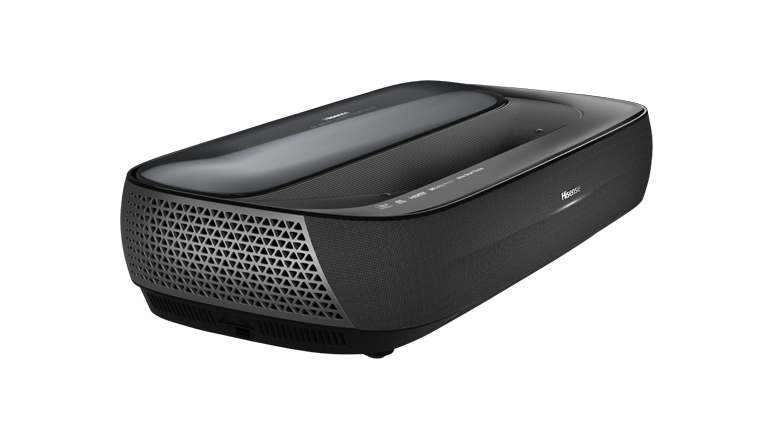
Dimensions (hwd) 16 x 61 x 35cm
Screen size 100 inches
Native resolution 4K (via DLP ‘double flashing’)
Input lag in game mode 64ms
The 100L9GTUK claims to be a 4K projector. As usual with projectors which are, like this one, based on DLP technology, however, it doesn’t actually carry a native 4K resolution. Instead it uses so-called double flashing technology to essentially get its DLP mirror/pixels to deliver two pixels per frame. While this might not sound ideal, and would be considered only a ‘pseudo’ 4K system by some, it’s worth noting that America’s Consumer Technology Association considers the double flashing DLP approach to provide a true 4K experience.
The 100L9GTUK calls on its brightness to deliver high dynamic range in the standard HDR10 format and the HLG format typically used for live HDR streams. There’s no Dolby Vision or HDR10+ support, but that’s only to be expected in the projector world (except that Samsung’s Premiere LSP9T rival UST laser projector does manage HDR10+).
Gamers may be a little disappointed by the 100L9GTUK in that its HDMIs don’t support 4K/120Hz gaming or VRR. The same applies to pretty much every other projector, however – but not to most of today’s premium television sets.
The 100L9GTUK also only gets input lag in gaming mode down to 64ms. That’s roughly double what we’d ideally be looking for from a projector, and could cost you a few lives in Battlefield or Call Of Duty.
The Hisense’s HDMIs support ARC for passing Dolby Atmos out to compatible audio devices, though. And, as noted earlier, the projector itself carries a built-in Dolby Atmos decoder despite only having a stereo speaker arrangement.
A couple of USB ports are provided for either multimedia playback or attaching streaming sticks, and finally there’s a fully fledged smart system present onboard in the form of Hisense’s VIDAA system. This delivers many of the streaming services you’d expect – Netflix, Amazon Prime Video, YouTube etc – all presented in a reasonably attractive and very easy to use interface. The only pity is that the version of VIDAA carried by the current 100L9GTUK doesn’t support either Disney+ or Apple TV. And it doesn’t seem these can be added by a firmware update, either.
Picture
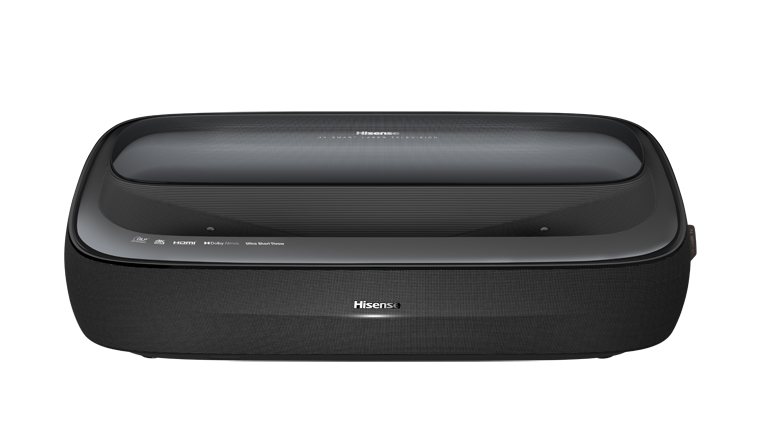
Running the 100L9GTUK first in fairly bright, typical daytime living room lighting conditions yields some seriously impressive results.
For starters, the triple laser optical system pumps out ferocious amounts of brightness. Enough to ensure that pictures really do remain watchable even with the curtains open – or all your living room lights on at night. The ALR screen clearly contributes to this daytime watchability, maintaining the brightness of the images coming from the projector while doing a strikingly good job of keeping out reflections from all the other light sources in your room.
The startling brightness also helps the 100L9GTUK retain richer colour saturations in a typically fairly bright room than we see with really any other projector bar Samsung’s Premiere LSP9T.
The brightness and colour intensity goes from surprisingly good in daylight conditions to flat out dazzling when you turn the lights off. In fact, just as the Laser TV solution as a package produces arguably the most watchable pictures in regular living room conditions that we’ve seen from a projector, so it also produces the most punchy images we’ve seen from a single packaged solution in a dark room.
Bright HDR scenes actually dazzle in dark rooms with the sort of intensity that you would only normally expect to see from a TV, rather than a projector. In fact, many budget and mid-range TVs would struggle to look as potent and punchy with bright HDR imagery as the 100L9GTUK does. Colours in dark rooms additionally look much more vibrant but also more natural on this tri-laser solution than they do on Hisense’s mono-laser L5 solution. In fact, the only projector that can rival or maybe even edge the 100L9GTUK for colour is Samsung’s Premiere LSP9T. And that doesn’t ship with an ALR screen included in its price.
Joining the brightness and richness of the 100L9GTUK’s daylight-condition pictures is some seriously impressive sharpness. Purists might not like to hear this, but its clarity, detailing and texturing look properly 4K. And there’s no hiding place for soft pictures on a 100-inch screen.
The clarity holds up decently well when there’s motion to handle too. Hisense’s motion processing can cause the picture to feel a little unnatural and ‘billowy’, even in its best Clear setting. But actually there’s not really any blurring if you just turn the motion processing off (though judder is a touch stronger without motion processing in play than we’d ideally like).
It’s important at this point to stress that all of the impressive stuff noted so far occurs pretty much exclusively in the 100L9GTUK’s Dynamic picture preset, and when watching bright images. Things aren’t nearly as rosy with any of the other presets, or when the images you’re watching are predominantly dark.
The issue with the other presets is that they either don’t deliver enough contrast and colour punch to maintain the key sense of dynamism and ambient light-defeating impact that Dynamic mode does, or else their colours don’t feel quite right. The 100L9GTUK seems much more comfortable running with the relatively cool colour palette of the Dynamic mode than with the warmer one introduced by most of the other presets, where skin tones in particular tend to look slightly jaundiced, and the overall range of colour seems to flatten.
The problem with dark scenes watched in a dark room is a familiar one with projectors designed to deliver pictures bright enough to stand up to high levels of ambient light: poor black levels.
A strong pall of greyness hangs over any dark scene, with no real attempt to deliver anything close to a black colour. Or even a dark grey, really. This leaves dark scenes in a dark room looking washed out and flat compared with their bright counterparts.
This is actually another reason we’d recommend using the Dynamic preset, since the extra punch it gives to bright parts of predominantly dark images at least distracts you from the uninspiring black levels.
Another issue with dark scenes that becomes much more noticeable in dark rooms is the appearance of a pretty large ‘hot spot’ of extra, slightly reddish brightness in the bottom third or so of the picture. This is strong enough to be instantly visible (especially with 2.35:1 movies that have black bars above and below them) and impossible to ignore. It’s even faintly visible in bright room environments, but not enough in these circumstances to class as a significant distraction.
As we’ve seen with one or two other three-laser projectors, including Samsung’s Premiere LSP9T, dark scenes also reveal evidence of the so-called rainbow effect, where stripes of red, green and blue can flit over bright highlights of mostly dark pictures. Especially if you move your eyes around the image.
The way the ALR screen works can result in the image looking noticeably dimmer, meanwhile, if you have to watch the screen from an angle, too. And, finally in the negative picture quality column, while the Dynamic preset is easily the most satisfying overall, it can cause some quite noticeable instability in baseline brightness levels when images cut abruptly between dark and light shots.
The net result of all these picture pros and cons is… complicated. No other all-in-one projector system we’ve seen can rival the 100L9GTUK for brightness and colour richness in a bright living room environment. Its 4K impact is excellent, too. But its difficulties with dark scenes compromise it against many much cheaper projectors – not to mention most TVs – when it comes to serious movie viewing sessions in darkened rooms.
Sound
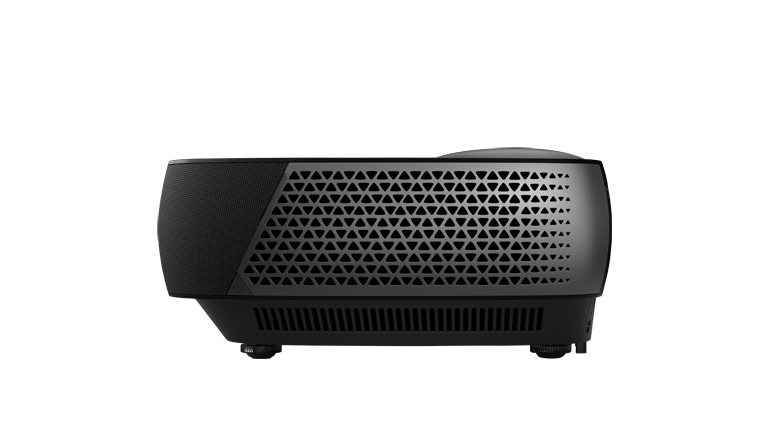
Judging the 100L9GTUK’s 2x20W speaker system is an exercise in relativity. Compared with the sound systems you get in the vast majority of projectors it sounds good. Louder, more expressive, and more dynamic. It’s less thin and tinny, too, than the sound we hear from some budget TVs, and even manages to sound a bit more spacious with Dolby Atmos soundtracks than normal stereo.
Compared with the sound available these days from some premium TVs, though, the 100L9GTUK’s audio lacks projection (pun intended), struggling to expand out from the projector’s body work in the way it needs to in order to match the scale of the 100-inch pictures. There’s something quite low-fi and hemmed in about its sound too, and its limitations when it comes to throwing sound mean that dialogue can quite often sound dislocated from the pictures appearing on the screen.
Verdict
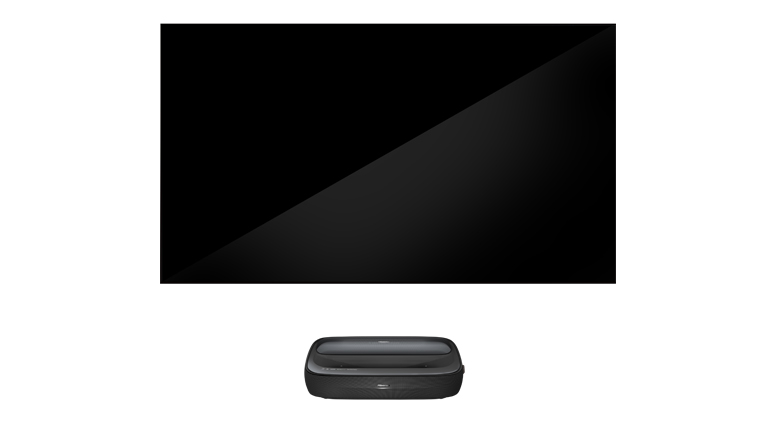
The 100L9GTUK is a classic game of two halves. In relatively bright room conditions – of the sort, to be fair, many people spend much of their telly-watching time in – its pictures hold up better than those of any all-in-one rival projector solution. Better than you might think possible, in fact.
Unfortunately, though, the 100L9GTUK can’t control the intensity of its light well enough to manage dark scenes in a darker setting.
All of which means that while it does enough things right to deserve to find an audience among big-screen devotees, its picture performance sees it ending up falling a little uncomfortably between two stools: not adaptive enough when it comes to changing room conditions to rival a premium (though likely significantly smaller) OLED or LCD TV, but also not as engaging in cinema room conditions as a good, dedicated ‘regular throw’ home entertainment projector.
SCORES
- Picture 3
- Sound 3
- Features 4
MORE:
Read our review of the Samsung Premiere LSP9T
Also consider the Optoma UHZ65LV
Or try a big TV instead: read our Samsung QE75QN900A review
Best projectors 2022 with Full HD, 4K, portable and short throw
What Hi-Fi?, founded in 1976, is the world's leading independent guide to buying and owning hi-fi and home entertainment products. Our comprehensive tests help you buy the very best for your money, with our advice sections giving you step-by-step information on how to get even more from your music and movies. Everything is tested by our dedicated team of in-house reviewers in our custom-built test rooms in London, Reading and Bath. Our coveted five-star rating and Awards are recognised all over the world as the ultimate seal of approval, so you can buy with absolute confidence.

